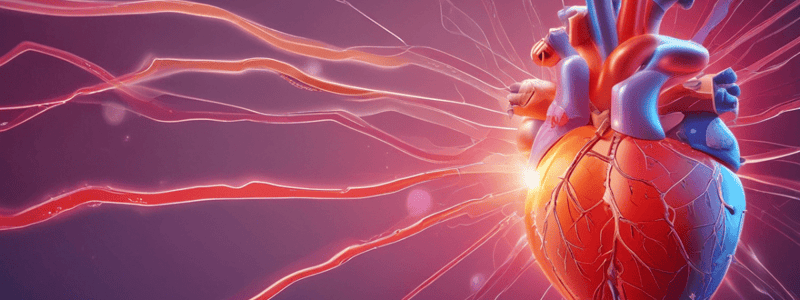Podcast
Questions and Answers
The ECG can detect the direction and length of time of a signal, as well as how much ______ was depolarized.
The ECG can detect the direction and length of time of a signal, as well as how much ______ was depolarized.
tissue
ECG readings are used to detect problems with the ______ activities in the heart.
ECG readings are used to detect problems with the ______ activities in the heart.
electrical
The ECG records the difference in surface electrical ______ at each electrode in a lead and compares them to one another.
The ECG records the difference in surface electrical ______ at each electrode in a lead and compares them to one another.
potential
Electrical activity moving towards the positive electrode in the lead will be an upward ______ on the ECG output, and it indicates a depolarization.
Electrical activity moving towards the positive electrode in the lead will be an upward ______ on the ECG output, and it indicates a depolarization.
If the wave is going towards the negative electrode in the lead, it will manifest as a downward ______ on the ECG reading.
If the wave is going towards the negative electrode in the lead, it will manifest as a downward ______ on the ECG reading.
The ECG reflects patterns of action ______ firing throughout all of the cells of the myocardium.
The ECG reflects patterns of action ______ firing throughout all of the cells of the myocardium.
The electrical signal originates at the ______ (SA node).
The electrical signal originates at the ______ (SA node).
The signal passes to the ______ node, at the base of the atria.
The signal passes to the ______ node, at the base of the atria.
The signal then passes to the ______ of the heart.
The signal then passes to the ______ of the heart.
The signal spreads back up through the ______.
The signal spreads back up through the ______.
The body is primarily filled with ______, and water is a good electrical conductor.
The body is primarily filled with ______, and water is a good electrical conductor.
Each electrode is connected to a ______ recording device and arranged in leads.
Each electrode is connected to a ______ recording device and arranged in leads.
The ups and downs on the ECG graph represent ______, not contraction.
The ups and downs on the ECG graph represent ______, not contraction.
The P-wave represents the ______ depolarization that happens before contraction.
The P-wave represents the ______ depolarization that happens before contraction.
The QRS complex represents ______ depolarization.
The QRS complex represents ______ depolarization.
The T-wave is the period of time when the ______ repolarize.
The T-wave is the period of time when the ______ repolarize.
The R-wave is so much larger than the other waves because the ______ walls are very thick and the cells all depolarize together.
The R-wave is so much larger than the other waves because the ______ walls are very thick and the cells all depolarize together.
The size of the T-wave varies from person to person, but the ______ for the QRS complex or P-waves are similar in amplitude from person to person.
The size of the T-wave varies from person to person, but the ______ for the QRS complex or P-waves are similar in amplitude from person to person.
Flashcards are hidden until you start studying




